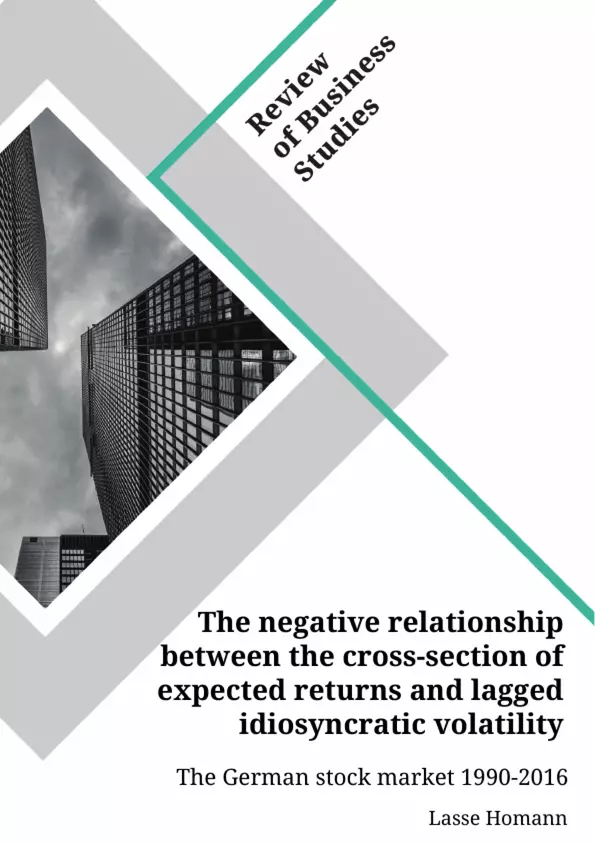The main goal of this thesis is to examine whether the negative relationship between the cross-section of expected returns and lagged idiosyncratic volatility also can be found for the German stock market for the period of January 1990 through June 2016, by sorting stocks into portfolios on the basis of their idiosyncratic volatility estimates. This procedure follows Ang et al. (2006).
Similar to the findings of Ang et al. (2006) for the US stock market this paper shows that there is a significant difference in returns relative to the Fama-French three-factor model, between portfolios of stocks with high and portfolios of stocks with low past idiosyncratic volatility.
Although for the period 1990 - 2016 no relationship between lagged idiosyncratic volatility and the cross-section of stock returns has been found, the Idiosyncratic Volatility Puzzle reveals itself for the sub-period 2003 - 2016, when the respective portfolios of stocks with different levels of idiosyncratic volatility are controlled for size.
Inhaltsverzeichnis (Table of Contents)
- 1 Introduction
- 2 Literature
- 3 Data
- 4 Methodology
- 5 Results
- 5.1 Estimating Idiosyncratic Volatility
- 5.2 Patterns in Average Returns January 1990 - June 2016.
- 5.3 Patterns in Average Returns January 2003 - June 2016.
- 6 Conclusion
- 7 Appendix
- 7.1 Portfolio Strategies January 1990 - June 2016
- 7.2 Portfolio Strategies January 2003 - June 2016
Zielsetzung und Themenschwerpunkte (Objectives and Key Themes)
This research aims to investigate whether the negative relationship between the cross-section of expected returns and lagged idiosyncratic volatility, known as the Idiosyncratic Volatility Puzzle, exists in the German stock market during the period of January 1990 through June 2016. This is achieved by sorting stocks into portfolios based on their idiosyncratic volatility estimates and analyzing their returns.
- The Idiosyncratic Volatility Puzzle
- The relationship between idiosyncratic volatility and expected stock returns
- The German stock market
- Portfolio formation based on idiosyncratic volatility estimates
- The CAPM and the Fama-French three-factor model
Zusammenfassung der Kapitel (Chapter Summaries)
- Chapter 1: Introduction
- Chapter 2: Literature
- Chapter 3: Data
- Chapter 4: Methodology
- Chapter 5: Results
This chapter introduces the research question and provides context by outlining the limitations of the Capital Asset Pricing Model (CAPM) and the development of the Fama-French three-factor model. The chapter then discusses the concept of idiosyncratic risk and its potential implications for investors, particularly in the context of incomplete information and transaction costs. Finally, the chapter reviews existing literature on the Idiosyncratic Volatility Puzzle, highlighting its relevance to the current research.
This chapter delves into the existing empirical literature on the Idiosyncratic Volatility Puzzle. It reviews the work of Fama and MacBeth (1973), which initially examined the role of idiosyncratic volatility in asset pricing, and subsequent research that has either produced inconsistent results or failed to show significance. The chapter also explores the study by Malkiel and Xu (2002), which replicated the work of Fama and MacBeth (1973), and its findings.
This chapter provides a detailed explanation of the data used in the research. It discusses the specific data sources, the time period covered, and the methodology employed for data selection and cleaning.
This chapter outlines the methodology used in the research, including the estimation of idiosyncratic volatility, the formation of portfolios based on these estimates, and the statistical analysis applied to assess the relationship between lagged idiosyncratic volatility and expected stock returns.
This chapter presents the findings of the research, analyzing the relationship between idiosyncratic volatility and expected stock returns in the German stock market. It explores the results for both the overall period and specific sub-periods.
Schlüsselwörter (Keywords)
The key terms and concepts explored in this work include idiosyncratic volatility, expected stock returns, the Idiosyncratic Volatility Puzzle, the CAPM, the Fama-French three-factor model, the German stock market, portfolio formation, and statistical analysis.
- Quote paper
- Lasse Homann (Author), 2018, The negative relationship between the cross-section of expected returns and lagged idiosyncratic volatility. The German stock market 1990-2016, Munich, GRIN Verlag, https://www.grin.com/document/540162



